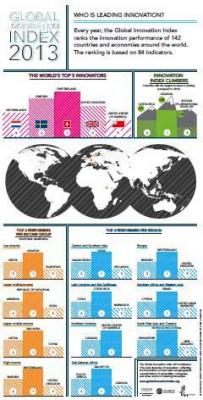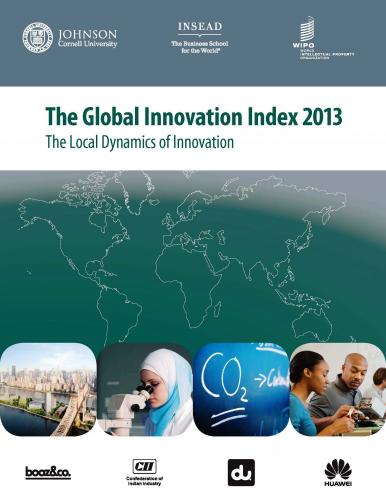Innovation increases worldwide despite economic crisis

ROME--The 2013 Global Innovation Index (GII) has been released, revealing that the United States has rejoined the five most innovative nations and the United Kingdom has moved up to the third spot. Switzerland retains its place at the top. Italy ranks 29th.
The Global Innovation Index is a recognition of the key role that innovation plays as a driver of economic growth and prosperity. It is also an acknowledgement of the need for a broad horizontal vision of innovation that can be applied to both developed and emerging economies and includes indicators that go beyond the traditional measures of innovation (such as the level of research and development in a given country).
Despite the economic crisis, innovation is alive and well. Research and development spending levels are surpassing 2008 levels in most countries and successful local hubs are thriving. A group of dynamic middle- and low-income countries – including China, Costa Rica, India, and Senegal - are outpacing their peers, but haven’t broken into the top of the GII 2013 leader board.
This year’s report casts additional light on the local dynamics of innovation, an area which has remained under-measured globally. It shows the emergence of original innovation eco-systems, and signals a needed shift from the usual tendency to try and duplicate previously successful initiatives.
“Dynamic innovation hubs are multiplying around the world despite the difficult state of the global economy. These hubs leverage local advantages with a global outlook on markets and talent,” said WIPO Director General Francis Gurry. “For national-level policy makers seeking to support innovation, realizing the full potential for innovation in their own backyards is often a more promising approach than trying to emulate successful innovation models elsewhere.”
The GII 2013 looked at 142 economies around the world, using 84 indicators including the quality of top universities, availability of microfinance and venture capital deals - gauging both innovation capabilities and measurable results.
Published annually since 2007, this sixth GII has become a valuable benchmarking tool for business executives, policy makers and other stakeholders seeking insight into the state of innovation around the world on a continual basis. The 2013 GII was published by Cornell University, INSEAD, and the World Intellectual Property Organization (WIPO).
This year’s study benefits from the experience of its Knowledge Partners: Booz & Company, the Confederation of Indian Industry, du and Huawei, as well as of an advisory board of 14 international experts. United Nations Secretary-General Ban Ki-moon joined the authors of the report and its Knowledge Partners in presenting the GII 2013 findings at the High-Level Segment of the United Nation’s Economic and Social Council (ECOSOC).
The High Level Segment, held July 1-4 in Geneva, brings together heads of state, ministers and heads of international agencies, this year focusing in particular on the role of science, technology and innovation and the potential of culture in achieving the Millennium Development Goals.
Top Ten 2013 ranking
1. Switzerland (Number 1 in 2012)
2. Sweden (2)
3. United Kingdom (5)
4. Netherlands (6)
5. United States of America (10)
6. Finland (4)
7. Hong Kong (China) (8)
8. Singapore (3)
9. Denmark (7)
10. Ireland (9)
Switzerland and Sweden’s performance reflect the fact that both countries are leaders in all components or 'pillars' of the GII as they consistently rank in the top 25.
The United Kingdom has a well-balanced innovation performance (ranking 4th in both input and output), in spite of a relatively low level of growth in labor productivity.
The United States continues to benefit from its strong education base (especially in terms of top-rank universities), and has seen strong increases in software spending and employment in knowledge-intensive services. The last time the US was in the GII top 5 was in 2009, when it was number one.
Italy is in 29th placeafterthe majority ofEuropean countries, includingMalta, Cyprusand Estonia, afterNew Zealand andSouth Korea,afterIceland andAustralia.However, since the GII 2012, Italy has climbed 7 rankings from its previous ranking of 36th.
2013 Top Rankings by Region
|
Rank in Region |
GII 2013 Overall Rank |
Country Name |
|---|---|---|
|
Central and Southern Asia |
||
|
1 |
66 |
India |
|
2 |
84 |
Kazakhstan |
|
3 |
98 |
Sri Lanka |
|
Sub-Saharan Africa |
||
|
1 |
53 |
Mauritius |
|
2 |
58 |
South Africa |
|
3 |
89 |
Uganda |
|
Southeast Asia and Oceania |
||
|
1 |
7 |
Hong Kong (China) |
|
2 |
8 |
Singapore |
|
3 |
17 |
New Zealand |
|
Latin America and the Caribbean |
||
|
1 |
39 |
Costa Rica |
|
2 |
46 |
Chile |
|
3 |
47 |
Barbados |
|
Northern Africa and Western Asia |
||
|
1 |
14 |
Israel |
|
2 |
27 |
Cyprus |
|
3 |
38 |
United Arab Emirates |
|
Europe |
||
|
1 |
1 |
Switzerland |
|
2 |
2 |
Sweden |
|
3 |
3 |
United Kingdom |
|
Northern America |
||
|
1 |
5 |
United States of America |
|
2 |
11 |
Canada |
“The results of the GII provide testimony to the global nature of innovation today," stressed Mr. Soumitra Dutta, co-editor of the report and Anne and Elmer Lindseth Dean, Samuel Curtis Johnson Graduate School of Management, Cornell University. "The top 25 ranked countries on the GII are a mix of nations from across the world – North America, Europe, Asia, Oceania and the Middle East. While high income economies dominate the list, several new players have increased their innovation capabilities and outputs. On average, high-income countries outpace developing countries by a wide margin across the board in terms of scores; a persistent innovation divide exists.”
“Business, government and civil society all offer new solutions and fresh ways of collaborating to spur innovation at local, national and even global levels,” said Mr. Bruno Lanvin, the report’s co-editor and Executive Director of INSEAD’s European Competitiveness Initiative.
“In fact, innovation is rapidly becoming a rallying symbol for forces of progress and reform around the world. Although our findings show that daunting challenges remain for many new players, we also see exciting examples of innovation success, including in some of the poorest countries. This is a source of optimism about the future of global innovation and economic recovery.”
How “Innovation Learners” Can Leverage Their Strengths
Among the encouraging signs identified by GII 2013, 18 emerging economies are outperforming other countries in their respective income groups in order of distance: the Republic of Moldova, China, India, Uganda, Armenia, Viet Nam, Malaysia, Jordan, Mongolia, Mali, Kenya, Senegal, Hungary, Georgia, Montenegro, Costa Rica, Tajikistan and Latvia.
All of them demonstrate rising levels of innovation compared with their peers. Even if progress is not uniform, this is a result of tackling the formulation of a good policy-mix on all meaningful fronts: institutions, skills, infrastructures, integration to global markets and linkages with the business community.
By and large, Latin America is the region that has seen the most significant improvement in GII rankings, with Costa Rica taking the lead regional position.
“Underperforming countries can boost their innovation capabilities by developing hubs in which large companies, whose business goals are aligned with the objectives of the innovation hub, can play a key catalyst role,” said Mr. Barry Jaruzelski, Senior Partner and leader of the Global Engineered Products & Services Practice at Booz & Company.
“Enterprise champions, including state-owned enterprises, family-owned conglomerates, and multinational corporations, can be the critical drivers of innovation hub activities. These enterprise champions can facilitate the building of hub capabilities and their talent pools by stimulating innovation and by helping to bridge the gap between research and commercial success.”
Innovation Leaders and “Innovation Learners”
The GII 2013 shows a striking pattern of stability among the most innovative nations. Whether we look at the top 10 or top 25 innovators in the world, GII rankings show that that while individual countries swap their respective rankings within these groups, not a single country moved in or out of such groups in 2013.
One interpretation of this is that innovation success leads to the emergence of a virtuous circle: once a critical threshold has been reached, investment attracts investment, talent attracts talent, and innovation generates more innovation.
Through several of its analytical chapters, the 2013 edition of GII explores how innovation has benefitted from ‘local specifics’ in different parts of the world. One key message is that too many innovation strategies have been focused on trying to replicate previous successes elsewhere, like Silicon Valley in California. However, fostering local innovation requires strategies that should be deeply rooted in local comparative advantages, history and culture. They should be combined with a global approach to reach out to foreign markets, and attract overseas talent.
“The local dynamics of innovation varies considerably across the globe and influences innovation measurement at the unit level. Learning from the local innovation systems adds newer dimensions to existing measurement approaches and challenges. The focus of this year’s GII makes it a valuable guide for the policy makers to develop specific strategies relevant to their local Innovation eco-system,” said CII Director General Chandraji Banerjee.
“The creation of an environment that could unleash the potential for innovation for all in a sustainable manner is the way to unlock the true, tangible potential of value creation; it will lay the groundwork for societal change and develop a framework for cohesive synergies through collaboration. The unprecedented socio-economic momentum that has been created in the last few decades in the United Arab Emirates makes this country very well positioned to continue to play a pivotal role in this exciting journey as a regional hub for innovation,” said Mr. Osman Sultan, Chief Executive Officer of du.Research and Development Strong.
On the research and development (R&D) front, GII 2013 brings a dose of cautious optimism: despite adversity and tightened budget policies, R&D expenditures have grown since 2010. On the business front, the R&D expenditures of top 1,000 R&D spending companies have grown between 9 and 10 % in 2010 and 2011. A similar pattern has been observed in 2012.
A most remarkable characteristic of that trend is that emerging markets have increased their R&D faster than high-income countries. Over the last five years, China, Argentina, Brazil, Poland, India, Russia, Turkey and South Africa (in that order) have been at the forefront of this phenomenon. Emerging markets, and notably China, are also largely driving the growth in patent filings worldwide.
“Growing research and development investments and the rising number of intellectual property patents filed are tangible examples of a growing commitment to innovation,” said Mr. Li Yingtao, Head of Huawei’s 2012 R&D laboratories. “In the global economy, innovation from anywhere can drive change and create new opportunities everywhere. Everyone concerned with innovation as a catalyst for economic and social development needs to remain focused on how the value of innovation is to transform industries, businesses and people’s lives, not just locally but across the world.”



